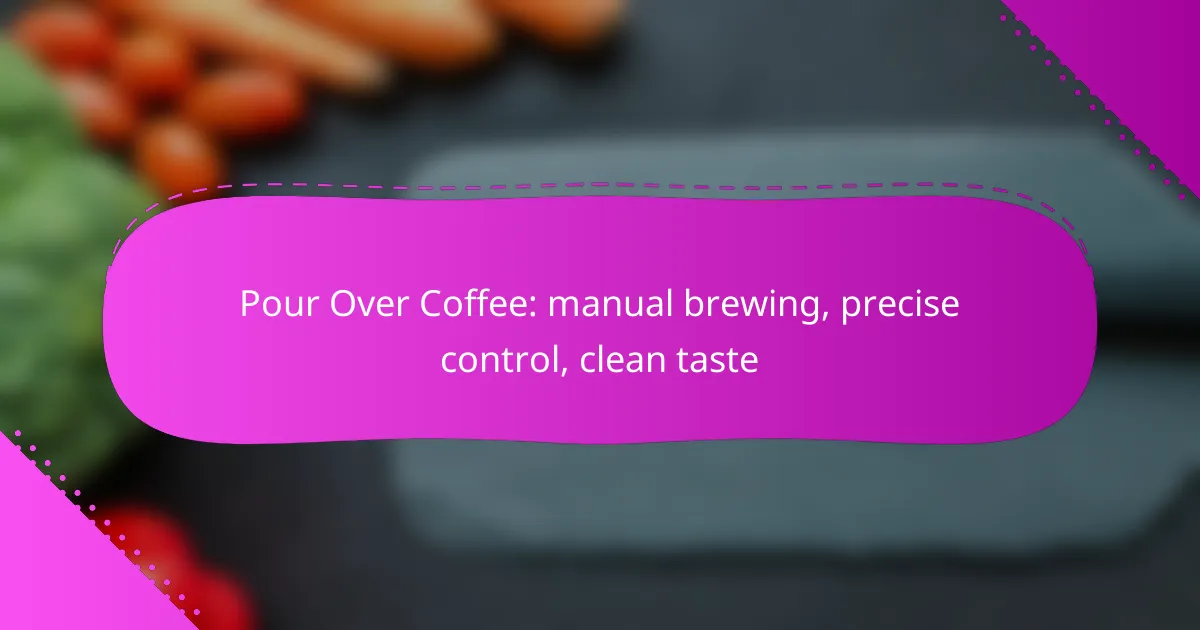Pour over coffee is a manual brewing method that provides coffee lovers with precise control over the extraction process, resulting in a clean and flavorful cup. By carefully following specific steps and selecting high-quality ingredients, you can create a coffee experience that highlights the unique characteristics of your chosen beans.
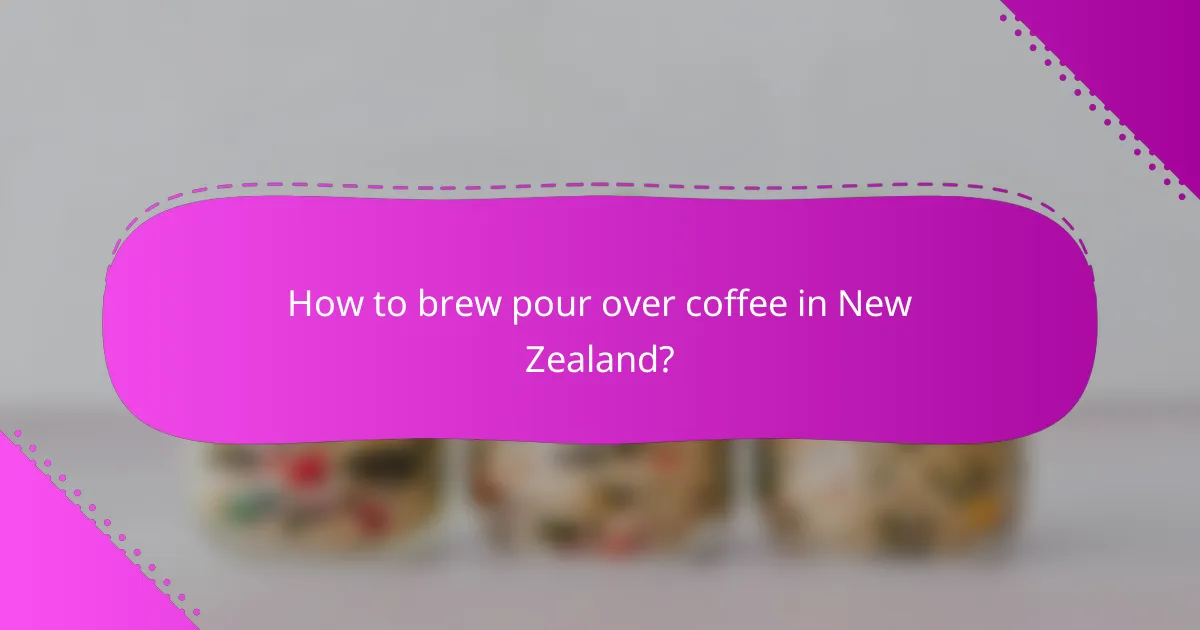
How to brew pour over coffee in New Zealand?
Brewing pour over coffee in New Zealand involves a manual process that allows for precise control over extraction, resulting in a clean and flavorful cup. By following specific steps and using quality ingredients, you can achieve a delightful coffee experience tailored to your taste preferences.
Step-by-step brewing process
To brew pour over coffee, start by measuring your coffee and water. A common ratio is 1:15, meaning for every gram of coffee, use about 15 grams of water. Begin by boiling water and letting it cool slightly before pouring.
Place a filter in your pour over device and rinse it with hot water to eliminate any paper taste. Add the ground coffee to the filter, then slowly pour hot water in a circular motion, allowing the coffee to bloom for about 30 seconds. Continue pouring until you reach your desired amount of brewed coffee.
Recommended coffee beans for pour over
For pour over coffee, choose medium to light roast beans that highlight the coffee’s natural flavors. Single-origin beans from regions like Ethiopia or Kenya are popular for their fruity and floral notes.
Look for freshly roasted beans, ideally within a few weeks of roasting, to ensure maximum flavor. Local roasteries in New Zealand often offer a variety of options, so consider trying different beans to find your favorite.
Essential equipment for pour over
The essential equipment for brewing pour over coffee includes a pour over dripper, such as a V60 or Chemex, a kettle with a gooseneck spout for precise pouring, and a scale to measure coffee and water accurately.
Additionally, a coffee grinder is crucial for achieving the right grind size, typically medium-fine for pour over. Investing in a good quality grinder will significantly enhance your brewing results.
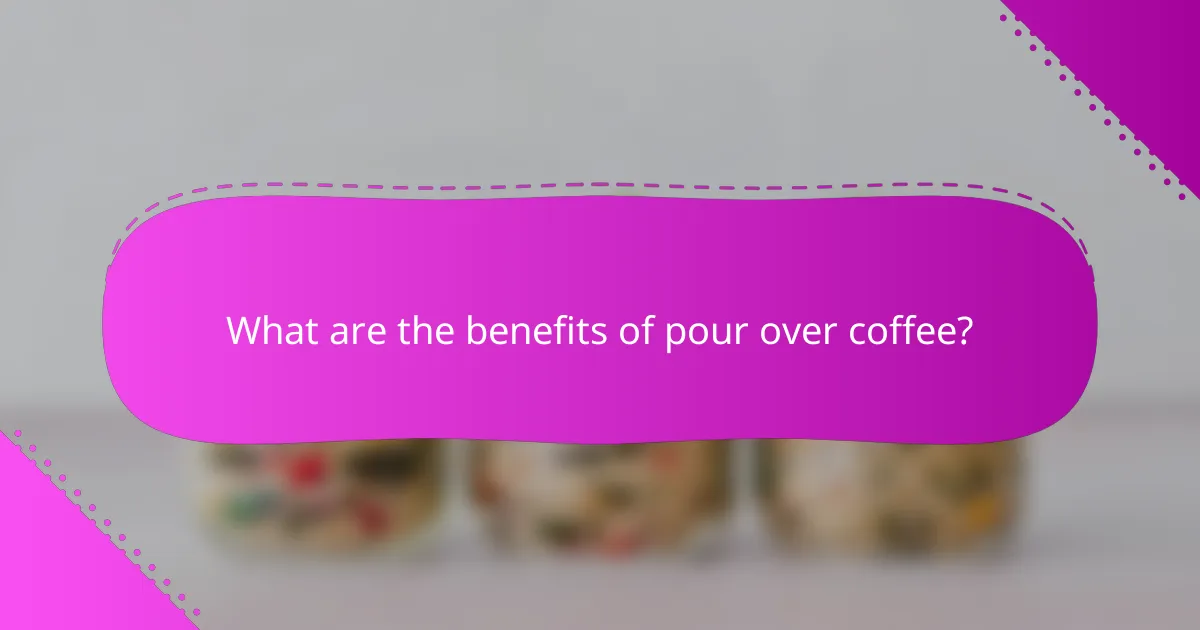
What are the benefits of pour over coffee?
Pour over coffee offers several advantages, including enhanced flavor and precise control over the brewing process. This method allows coffee enthusiasts to achieve a clean taste that highlights the unique characteristics of different beans.
Enhanced flavor extraction
Pour over brewing facilitates optimal flavor extraction by allowing water to flow evenly through the coffee grounds. This method promotes a balanced extraction, resulting in a cup that showcases the coffee’s natural sweetness and acidity.
Using a medium grind size and a water temperature between 90°C and 96°C can significantly improve the flavor profile. Experimenting with different coffee-to-water ratios, typically around 1:15 to 1:17, can also enhance taste, allowing for a richer and more complex cup.
Control over brewing variables
One of the key benefits of pour over coffee is the ability to control various brewing variables, such as water temperature, flow rate, and brew time. This level of control enables you to fine-tune the brewing process to match your taste preferences.
For instance, adjusting the pouring technique—whether using a steady stream or circular motion—can influence extraction rates. Aim for a total brew time of around 3 to 4 minutes for optimal results, but feel free to adjust based on your desired flavor intensity.
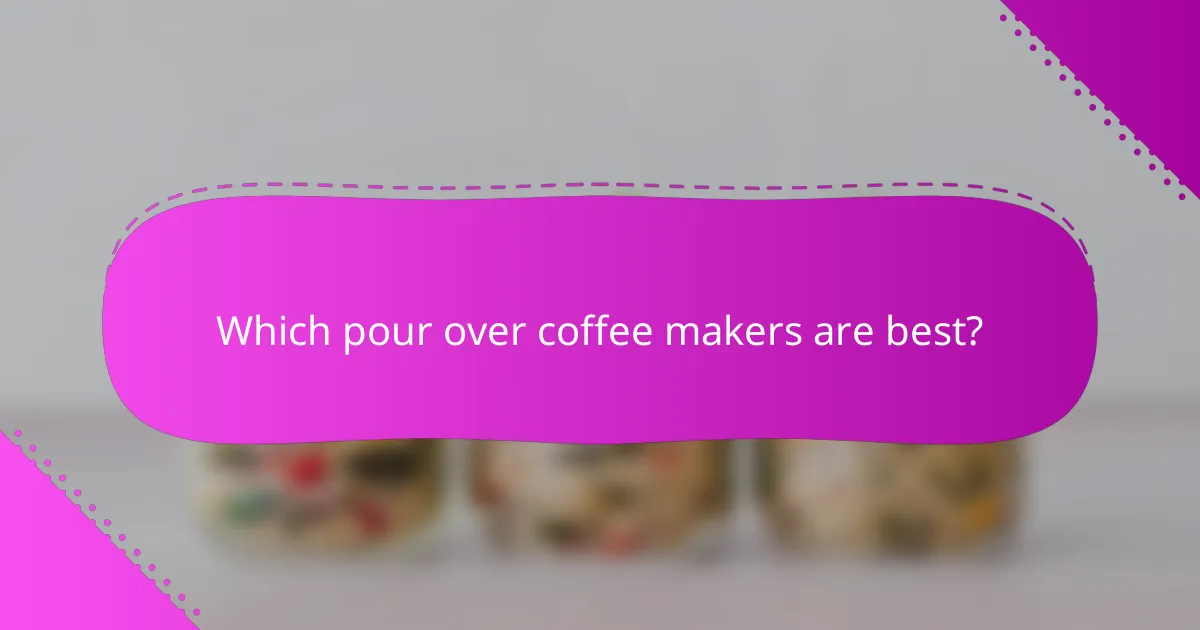
Which pour over coffee makers are best?
The best pour over coffee makers emphasize manual brewing, allowing for precise control and a clean taste. Popular options include the Hario V60, Chemex, and Kalita Wave, each offering unique features that cater to different brewing preferences.
Hario V60 overview
The Hario V60 is a cone-shaped dripper known for its versatility and ease of use. It allows for a variety of brewing techniques, making it suitable for both beginners and experienced coffee enthusiasts.
With a range of materials available, including ceramic, glass, and plastic, users can choose based on their aesthetic preferences and thermal retention needs. The V60’s spiral ridges promote optimal water flow, enhancing extraction and flavor.
Chemex features and benefits
The Chemex is a stylish, hourglass-shaped coffee maker that combines functionality with elegance. Its thick paper filters yield a clean cup, removing oils and sediment, which is ideal for those who prefer a lighter taste.
Available in various sizes, the Chemex is perfect for brewing multiple cups at once. Its design also allows for easy pouring and serving, making it a great choice for gatherings or coffee enthusiasts who enjoy sharing their brews.
Kalita Wave comparison
The Kalita Wave features a flat-bottom design with three small holes, promoting even extraction and reducing the risk of channeling during brewing. This design helps achieve a consistent flavor profile, making it a favorite among precision-focused brewers.
Available in stainless steel, glass, and ceramic, the Kalita Wave caters to different preferences while maintaining durability. Its ease of use and forgiving nature make it suitable for both novices and seasoned coffee drinkers looking for reliable results.
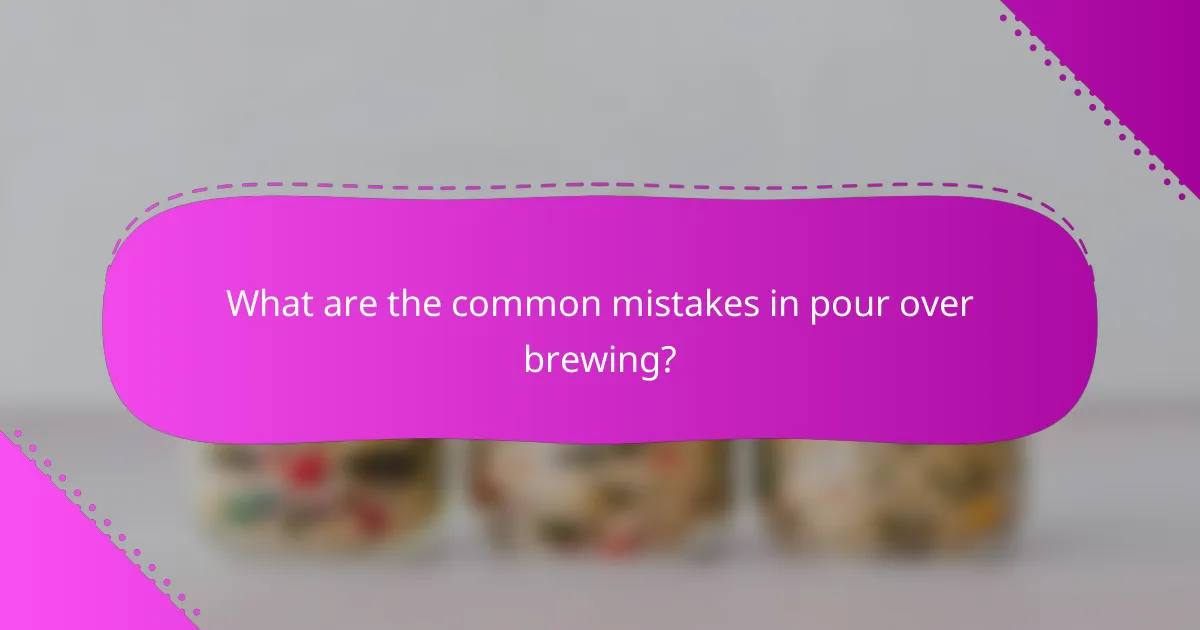
What are the common mistakes in pour over brewing?
Common mistakes in pour over brewing include using the wrong grind size, poor water temperature, and improper pouring techniques. Each of these factors can significantly affect the extraction and flavor of the coffee, leading to a less than optimal cup.
Incorrect grind size
The grind size of coffee beans is crucial for proper extraction during pour over brewing. A grind that is too coarse can result in under-extraction, leading to a weak and sour taste, while a grind that is too fine may cause over-extraction, resulting in bitterness. Aim for a medium grind, similar to granulated sugar, to achieve a balanced flavor.
To avoid this mistake, consider using a burr grinder for consistent results. Adjust the grind size based on your brewing time; a shorter brew time typically requires a finer grind, while a longer brew time benefits from a coarser grind.
Poor water temperature
Water temperature plays a vital role in the extraction process during pour over brewing. The ideal temperature range is between 90°C to 96°C (194°F to 205°F). Water that is too hot can scorch the coffee, while water that is too cool may not extract the flavors effectively.
To ensure proper water temperature, use a thermometer or let boiling water sit for about 30 seconds before pouring. This simple adjustment can greatly enhance the flavor profile of your coffee.
Improper pouring technique
The way you pour water over the coffee grounds can impact the extraction and overall flavor. Pouring too quickly or unevenly can lead to inconsistent extraction, resulting in a cup that lacks depth. A slow, circular pouring motion helps saturate the grounds evenly.
Start by pouring a small amount of water to bloom the coffee, allowing gases to escape, then continue with a steady pour. Aim to pour in a controlled manner, taking about two to three minutes for the entire brewing process to ensure optimal extraction.
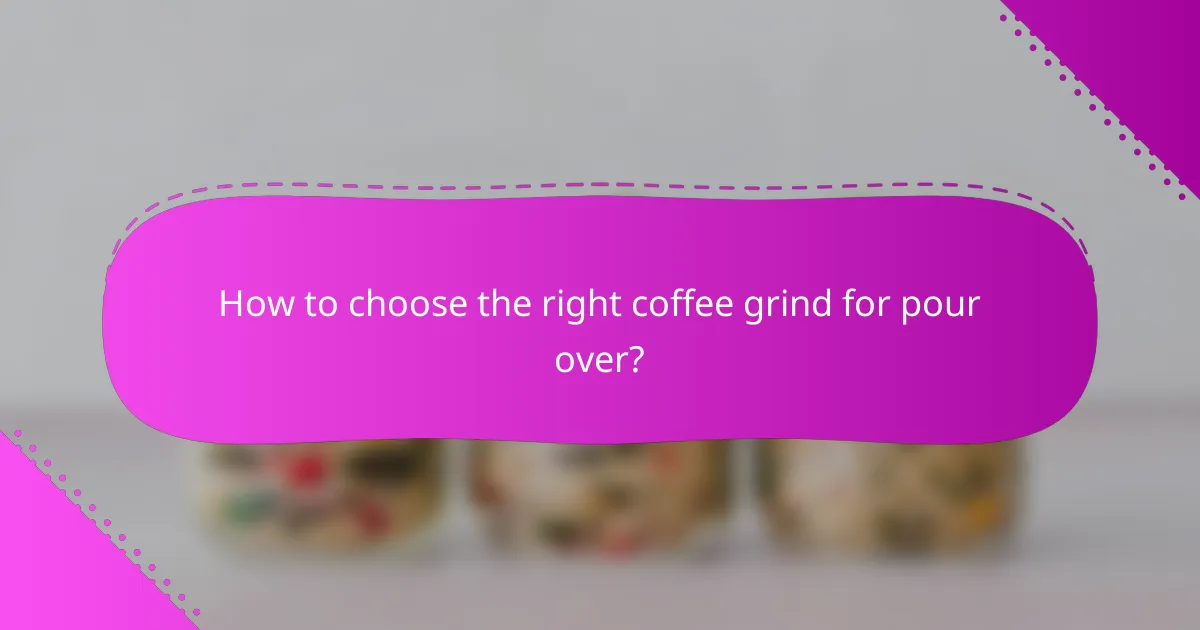
How to choose the right coffee grind for pour over?
Choosing the right coffee grind for pour over brewing is essential for achieving the desired flavor and extraction. A grind that is too fine can lead to over-extraction and bitterness, while a grind that is too coarse may result in under-extraction and weak taste.
Coarse vs medium grind
Coarse grind is typically used for methods like French press, while medium grind is ideal for pour over coffee. For pour over, the grind should resemble granulated sugar, allowing for optimal water flow and extraction. A medium grind strikes a balance between extraction speed and flavor clarity.
Using a coarse grind in pour over can lead to a slower extraction, which may cause the coffee to taste weak. Conversely, a fine grind can clog the filter and create a bitter brew. It’s crucial to find the right grind size to enhance the clean taste that pour over coffee is known for.
Impact on brewing time
The grind size directly affects brewing time in pour over coffee. A medium grind typically requires a brewing time of around 3 to 4 minutes, while a coarse grind may extend this to 4 to 5 minutes. Adjusting the grind size can help you control the extraction process and flavor profile.
If the grind is too fine, the water will pass through too slowly, leading to over-extraction and bitterness. On the other hand, a coarse grind will allow water to flow too quickly, resulting in under-extraction. Monitoring the brewing time and adjusting the grind size accordingly is key to achieving the perfect cup.
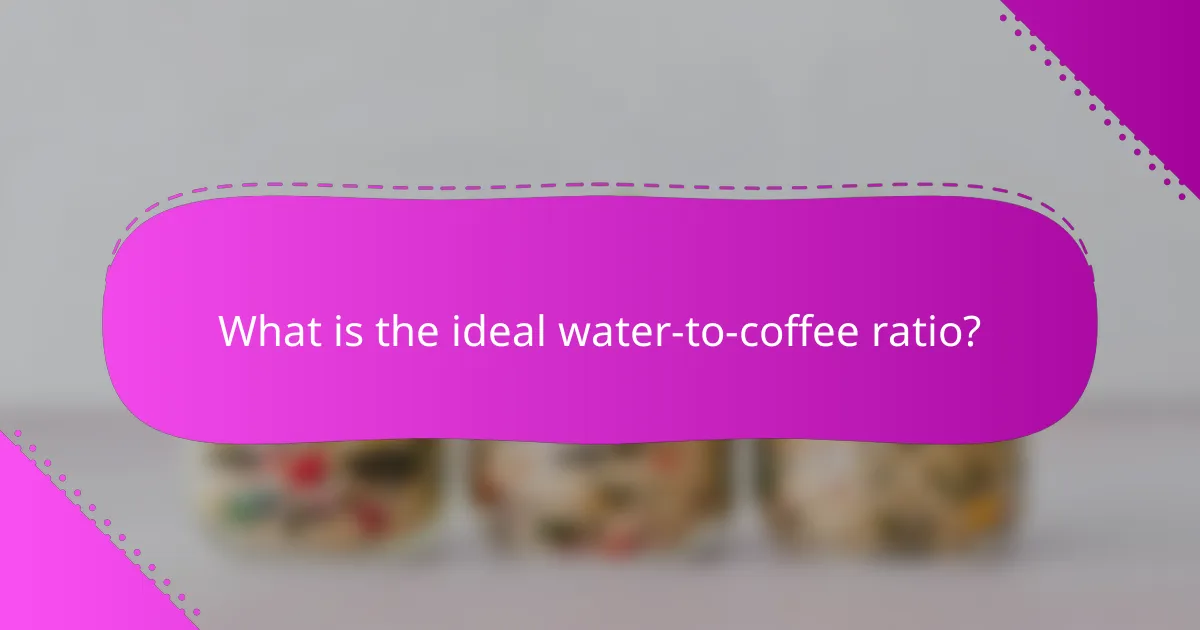
What is the ideal water-to-coffee ratio?
The ideal water-to-coffee ratio for pour over coffee typically ranges from 1:15 to 1:18, meaning for every gram of coffee, you should use 15 to 18 grams of water. This balance ensures a clean taste and allows for precise control over the brewing process.
Standard ratios for pour over
Standard ratios for pour over coffee often fall between 1:15 and 1:17. For example, using 20 grams of coffee, you would use between 300 to 340 grams of water. This range helps achieve a well-extracted flavor profile without being overly bitter or weak.
Many coffee enthusiasts recommend starting with a 1:16 ratio as a baseline. This provides a balanced cup that can be adjusted based on personal taste and the specific coffee beans used.
Adjusting for taste preferences
Adjusting the water-to-coffee ratio can significantly impact the flavor of your brew. If you prefer a stronger taste, consider using a ratio closer to 1:15. Conversely, if you enjoy a milder cup, a ratio of 1:17 or even 1:18 may be more suitable.
Experimenting with small adjustments can help you find your ideal balance. Keep notes on the ratios and flavors you prefer, as this will guide your future brewing sessions and enhance your overall coffee experience.

How to clean and maintain pour over equipment?
Cleaning and maintaining pour over equipment is essential for ensuring optimal flavor and longevity. Regular maintenance helps prevent coffee oils and residues from affecting the taste of your brews.
Daily cleaning routine
After each use, rinse your pour over dripper and carafe with hot water to remove coffee grounds and oils. If you use a paper filter, discard it and clean the dripper thoroughly. For glass or ceramic carafes, a gentle scrub with warm, soapy water is usually sufficient.
Deep cleaning methods
Once a week, perform a deeper clean by soaking your equipment in a solution of equal parts water and white vinegar for about 30 minutes. This helps to dissolve any stubborn coffee oils and mineral deposits. Rinse thoroughly afterward to ensure no vinegar taste remains.
Storage tips
Store your pour over equipment in a dry place to prevent mold growth. Avoid stacking items directly on top of each other to prevent scratches or damage. If you use a reusable metal filter, ensure it is completely dry before storing to avoid rust.
